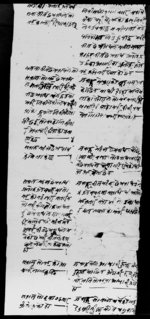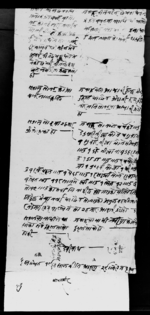A bayāna submitted by Devīnātha re the succession of Mahanta Chetranātha in Rānagāũ (VS 1964)
ID: K_0469_0045
Edited and
translated by Christof Zotter
Created: 2018-06-29;
Last modified: 2023-03-23
For the metadata of the document, click here
The accompanying edition, translation/synopsis and/or commentary are available under the terms of the Creative Commons Attribution-ShareAlike 4.0 International License
Abstract
In this statement made in front of Lieutenant Colonel Vīra Bahādūra Basynāt Kṣetrī of the Salyan district office (gauḍā) Devīnātha Bābājī answers questions regarding the death of Mahanta Chetranātha in Rānāgāũ, Salyan, the competing claims to the office of abbot, and the revenue of the monastery (maṭha).Diplomatic edition
[1r-part1]
⟪46⟫[seal]1दःलेःकःवीरवहादूर2वस्न्यात्क्षत्री1सल्ल्यानागौडाकालेकर्णैलवीरवहादुर•वस्न्यात
2क्षेत्रीकासामंनेमाभय़ाकोरानागाउकाम
3हंत्याईमुद्दामादेवीनाथवावाजीकोवय़ान्
4¯¯¯¯¯¯¯¯¯¯¯¯¯¯¯¯¯¯¯¯¯
[table1-part1]
| 1 | सव़ालमामुली¯¯¯¯¯¯¯१ | जवाफ्मेरामेरानाउ•देवीनाथवावुको नाउषीमानाथमहंतजातव्रार्ह पंन्तीनाथजोगीहुंघररानागाउ माछपेसासोरानागाउकामहंन्तम ठमाकाम्गर्छु•उमेरवर्ष३३कोभञा |
| 2 | सव़ालसोरानागाउकाम हंन्तकोथीय़ाहालकाहाछं न्¯¯¯¯ ¯¯¯¯¯२ | जवाफ्•सोरानागाउमामहंन्तछे त्रनाथथियानीज६४साल•जेष्ठ १७गतेमा•सोहीरानागाउमठ्मै प्रलोकभय़ोछैनंन्¯¯¯¯¯¯ |
| 3 | सव़ाल•नीजमहंन्तछेत्रना थप्रलोकहुनुभंन्दाअ गाडीवाःप्रलोकहुनवष तमानीजछेत्रनाथलेसो मठ्कस्लाईदीय़ाकाहुन्३ | जवाफ्•नीजमहंन्तछेत्रनाथप्रलो कहुनु•भंन्दा•४।५दीनअगाडी तिमीमसंगझगडानगर•मवाचे भंन्या•पनीय़ोमठकोकाम्तिमी लेगर्नुपर्न्याछममरीगञाँभने पनिय़ोमठ•तिम्रैहुन्याछभनी नीजछेत्रनाथले•मसंगभन्या काहुन्•नीजछेत्रनाथ•प्रलोक्हु नुभंन्दाअगाडीवा•प्रलोक्•हुनेव षतमानीजछेत्रनाथलेसोमठ्कसैलाईदीय़ाकोछैन¯¯¯¯ |
[1r-part2]
[table1-part2]
| 4 | सव़ाल•सोमठ्छेत्रनाथ लेमलाईअषत्यारीदीमहं न्तछत्रनाथस्वर्गेहुनुभो भनीतिमीलेवीन्तिपत्रपठा य़ाकोहुनाले•तिमीसंगसो धीन्छकीसोमठकोतिमीला ईअषत्यारीदीय़ाकोप्रमा णकेछ¯¯¯¯¯¯४ | जवाफ्ये़स्कुराकोकागजपत्र केहिछैन•माथीकेदफामालेषी य़ाकोवेहोराले•सोमठमलाईअ षत्यारीदीय़ाकोभनीबीन्तीपत्र ये़सगौडामाचढाईपठाय़ाकोहुं¯¯¯ |
| 5 | सव़ाल•महंन्तछेत्रनाथ कोचेलाकोछ¯¯¯¯¯५ | जवाफ्महंन्तछेत्रनाथ•चौघे रामापीर•वस्दा•लोकनाथलाईनी जछेत्रनाथलेचेलागरीराषेकोथी य़ोअरूचेलाछैन¯¯¯¯¯¯¯¯¯ |
| 6 | सव़ाल•महंन्तछेत्रनाथ• प्रलोकहुनेवषत्•मासो मठ्कोमहंत्याईतलाईभ य़ोभनीनीजलोकनाथला ईछेत्रनाथलेधाप्लगाई दीमेरोसेषपछीमहंन्तभैव स्नुभनीनीजछेत्रनाथलेभ नेकोछभनीनीजलोकना थलेलेषीदीय़ाकोछकसो हो¯¯¯¯¯¯¯¯¯\ | जवाफ्•नीजमहंन्त•छेत्रनाथप्रलो कहुनेवषतमामसाथैथीञासो मठतलाईभय़ोभनीलोकनाथला ईधापलगाय़ाकोमलाईथहाछैन |
| 7 | सव़ालसोमठ्कोआ म्दानीलगतकतिछ¯¯¯¯¯\ | जवाफये़तिआम्दानीहुंन्छभं[...] दुरूस्तथहाछैन•अंदाजीरू२दुईह जारजतिसोमठ्माआम्दानीहुदो हो¯¯¯¯¯ ¯¯¯¯¯¯¯¯¯ |
[1r-part3]
[table1-part3]
| 8 | सव़ालसोठ्मा२हजार कुंकेरकस्कोहो¯¯¯¯¯¯¯¯¯¯\ | जवाफ्सोमठलेचर्चेकोगाउ देउषुरीजील्लामौजेचगुव़ा[...] १सुनारजील्लामौजेसीसव़ा गाउ१दां•जील्लामावडहरागा उ१डाडागाउगाउ१चषौरा[...] जा१वुटहनीमौजा१श्रीगाउ[...] उ१रजपहलगाउ१पेदागाउ१रसल्ल्यांमौजेरानागा[...] १स्मेतज्मा११रसातसैह्यांगाउ१स्मेत•१२छ सो१२गाउकोसर्वांगिमाफिछसोगाउकोवे़तिवे़ति[...] तिहुंछभंन्यामलाईथाहाछैनसोगाउकोअसुलतहसीलवाट रमंडलाईरकम्वाटस्मेत•सो२हजार•आम्दानीहुदोहो¯¯¯¯¯¯¯¯¯¯ |
| 9 | सव़ाल•य़ोमाथीलेषा य़ाकोसवैदुरूस्तसाचो होकी¯¯¯¯¯¯¯¯¯¯\ | जवाफ्य़ोमाथी•लेषीय़ाकोसवै दुरूस्तसाचोहो¯¯¯¯¯¯¯¯¯¯¯¯ |
5देवीनाथ¯¯¯¯¯¯\
6ईतिसंम्वत१९६४साल्मीतिश्रावण•२९गतेरोज३शुभ्म्¯¯¯¯¯¯¯¯¯¯¯¯¯¯1सहीदेवीनाथ
2जीघररानागाउ1दःले•कः
2सही
Translation
[1r-part1]
461
[seal]
Da.2 L[ieutenant] C[olonel] Vīra Bahādura Basnyāt Kṣatrī
A statement by Devīnātha Bābājī in a lawsuit [regarding] the abbotship of Rānāgāũ3 made in the presence of L[ieutenant] Colonel Vīra Bahādura Basnyāt Kṣetrī of the Salyan4 district office (gauḍā)
[table1-part1]
| Question: general [introduction] ---1 | Answer: My name [is] Devīnātha; [my] father's name [is] Khīmānātha Mahanta. Caste (jāta): I am a Bārhapānthī Nāthajogī. Home: is in Rānāgāũ. Profession: I work in the monastery (maṭha) of the Rānāgāũ abbot (mahanta). Age: 33 years old. | |
| Question: Who was the mahanta of Rānāgāũ? Where is [he] at present? ---2 | Answer: The mahanta in Rānāgāũ was Chetranātha. In [the year VS 19]64, Jeṣṭha gate 17, the same passed away in the Rānāgāũ maṭha itself. [He] is no [more]. | |
| Question: To whom did the said Chetranātha give the maṭha before Chetranātha himself passed away or at the time of passing? ---3 | Four or five days before the said Chetranātha passed away Chetranātha himself said to me: "Don’t quarrel with me. Even if I survive, you'll need to do this maṭha's work [for me]. When I'm dead, too, this maṭha will be yours [to run]." Before the said Chetranātha passed away or at the time of passing, Chetranātha did not himself give the maṭha to any one [else]. |
[1r-part2]
[table1-part2]
| Question: Since you sent a petition (bintīpatra)5 stating: "Mahanta Chetranātha passed away after giving me authority [over] the maṭha," the question is: what proof is there of [your claim] that authority over the maṭha was given to you? ---4 | Answer: There is no official document (kāgajapatra) regarding this matter. I submitted the petition to this gauḍā, stating that authority [over] the maṭha was given to me as detailed in writing in the above section (of this statement). | |
| Question: Who is the disciple of Mahanta Chetranātha? ---5 | Answer: When Mahanta Chetranātha was residing as abbot (pīra) in Caugherā, Chetranātha himself made Lokanātha [his] disciple. There are no other disciples. | |
| Question: The said Lokanātha wrote that when Mahanta Chetranātha was about to pass away, Mahanta Chetranātha himself said, "The abbotship of the maṭha is yours"; [that] Chetranātha slapped him (on the back) [and] said, "After my death stay on as mahanta."6 How [can that] be? | Answer: At the time when Mahanta Chetranātha himself passed away, I was with [him]. I do not know if [the mahanta] said, "The maṭha is yours" and slapped Lokanātha (on the back). | |
| Question: How much is the revenue assessment of the maṭha? | Answer: I do not know exactly how much the revenue is. The revenue in the maṭha may be about 2 two thousand ru[pees]. |
[1r-part3]
[table1-part3]
| Question: That two thousand [rupees collected] in the maṭha are which [sums? from] what [sources? and] whose [levies?]? | Answer: The villages controlled by that maṭha are: [in] Deukhurī district (jillā), maujeCaguvā village 1,7 [in] Sunārajillā, maujeSīsavā village 1,8 in Dang9 jillā, Baḍaharā village 1,10 Ḍāḍāgāu village 1,11 Cakhaurāmaujā 1,12 Buṭahanīmaujā 1, Śrīgāũ village 1,13 Rajapahala village 1, Pedā village 1, and, [in] Salyan [jillā], maujā Rānāgāũ 114 ; [this makes] 11 [villages] in total, and together with SātasaiHyāṃgāu15 1, 12 [villages].16 These 12 villages are exempted from all taxes and levies (sarvāṅgimāphi). I do not know how much the [revenue?] from these villages is (in detail). 17 From the collection of sums owed by these villages and of the maṇḍalāi money18 the revenue may be those two thousand [rupees]. | |
| Question: Is all that is dictated above in accordance with the truth? | Answer: All that is written above is in accordance with the truth. |
Devīnātha - - -
Tuesday, the 29th solar day (gate) of Śrāvaṇa of the [Vikrama] era year 1964 (1907 CE). Auspiciousness.
signature Devīnātha, home Rānāgāũ
signature Da. L[ieutenant] C[olonel]
Commentary
Devīnātha's statement is only one of altogether eight witness statements19 collected during a lawsuit over the succession of Chetranātha (or Chatranātha), the abbot of Rānāgāũ.20 It was recorded in the presence of Vīra Bahādura Basnyāt Kṣetrī, an official of the Salyan district office, more than two weeks after the other statements, and is the only one that does not support his rival Lokanātha's claim of having been selected by the late mahanta as successor. It is exceptional for another reason, too. Probably to bolster his qualification for the desired office, Devīnātha is the only witness who relates any details regarding the landholdings and the revenue of the maṭha.21
Interestingly, although Devīnātha declares in the general introduction that he is the son of a former mahanta, Khīmānātha, he does not mention that the deceased Mahanta Chetranātha was his younger brother; a fact that was revealed to officials in Kathmandu only one year later in a joint report by Śamśera Bahādura Śāha (the king of Salyan) and the above-mentioned Vīra Bahādura Basnyāt Kṣetrī,22 which may have played a role in decision to appoint neither Lokanātha nor Devīnātha as abbot but rather a person of the prime minister's choosing, one untouched by the internal conflict (see Bouillier 1991[a]: 168 and Zotter 2018: 456).
The report just mentioned relates another interesting detail. Like his father Khīmānātha, Devīnātha was a disciple of Bhagavantanātha's fourth successor, Mahanta Jagadīśvaranātha. If Devīnātha was 33 years old in VS 1964 (the time of his statement) and Jagadiśvaranātha passed away in VS 1938, after tapping his disciple Khīmānātha to succeed him (see K_0469_0001), Devīnātha must have been younger than seven years old at the time of his initiation. More importantly, this initiation actually barred him from the roll of succession. It is stressed in Lokanātha's petition and in all the witness statements supporting it that, according to the yogīs' tradition, the mahanta selects his successor from among his own disciples. Thus, from the traditional point of view, Devīnātha—despite being a senior member of the tradition—had no right to claim the throne for himself, while Lokanātha, who was (as we know from the same report) the son of Khīmānātha's disciple and successor Hīrānātha (Mahanta Chetranātha's guru and predecessor), was indeed the legitimate heir, since he was the only disciple of the late Chetranātha, as even Devīnātha admits in his statement.



